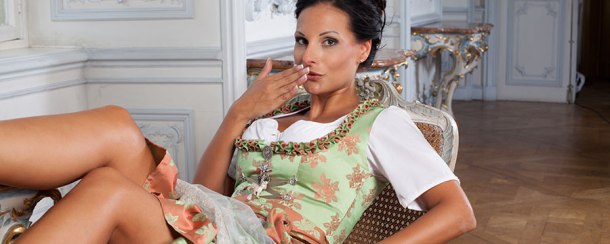Die Märchenhafte Kollektion von Dirndl Couture Astrid Söll verbindet traditionelle Stoffe und Designs von einst mit dem Zeitgeist und Modeanspruch von heute.
Das Dirndl im Unterschied zum Trachtenkleid fordert aber keinen regionalen Bezug und erhebt nicht den Anspruch eine klassische, traditionelle Volkstracht zu sein. Daher wird das Erscheinungsbild des Dirndlkleides und dessen Variationsvielfalt immer bunter, kreativer und exzentrischer!
Glamour und Glitzer gepaart mit Gebräuchen … Traum und Tradition sind die Assoziationen, die einem bei den Modellen in den Sinn kommen.
Ein bisschen Hollywood in Bayern! Mondän, moderne Mode im Alpenlook!
What Exactly Is A Dirndl?
A dirndl is a bodice dress, consisting of a wide skirt, a colourful apron, a bodice and a short or long sleeved white or chequered blouse. There are dozens of dirndl varieties. Many of them characterise a specific region.
dirndl dresses Contemporary dirndls Dirndl Dirndl Dress dirndl fashion Dirndl Mode dirndl outfit Dirndl Trachtenmode dirndl tradition Dress Dirndl fashion Trachtenmode Dirndl Dress fashion Dirndl Mode Dirndl Trachtenmode dirndl dress fashion dirndl mode dirndl trachtenmode tracht Arts Bavaria best dirndl fashion best dirndl shop Contemporary dirndls Crafts das drindl die dirndln dirndel Dirndl Dirndl Dress dirndl dresses dirndlmode Dirndl Trachtenmode Dress fashion Hollywood Mode mode dirndl Munich Oktoberfest online dirndlshop Shopping tolle dirndln tracht Trachten Trachtenmode worldwide dirndl fashion
Die Märchenhafte Kollektion von Dirndl Couture Astrid Söll verbindet traditionelle Stoffe und Designs von einst mit dem Zeitgeist und Modeanspruch von heute.
http://soell-dirndl.de/http://en.wikipedia.org/wiki/Dirndl
A dirndl [ˈdɪʁndl̩] is a type of traditional dress worn in Germany – especially Bavaria – Liechtenstein, Austria, and South Tyrol, based on the historical costume of Alpine peasants. Dresses that are loosely based on the dirndl are known as Landhausmode.
A dirndl skirt (sometimes spelled dirndle)[1] generally describes a light circular cut dress, gathered at the waist, that falls below the knee.[2][3][4]
The dirndl consists of a bodice, blouse, full skirt and apron. While appearing to be simple and plain, a properly made modern dirndl may be quite expensive as it is tailored and sometimes cut from costly hand-printed or silk fabrics. In the South German dialects (Bairisch), Dirndl originally referred to a young woman or a girl, and Dirndlgewand to the dress. Nowadays, Dirndl may equally refer to either a young woman or to the dress.
The winter style dirndl has heavy, warm skirts and aprons made of thick cotton, linen, velvet or wool, and long sleeves. The colors are usually rich and dark. The summer style is lighter and more frivolous, has short sleeves, and is often made of lightweight cotton.
Accessories may include a long apron tied round the waist, a waistcoat or a wool shawl. In many regions, especially the Ausseerland, vibrantly-colored, hand-printed silk scarfs and silk aprons are worn. As far as jewelry is concerned, women often sport necklaces, earrings and brooches made of silver, the antlers of deer or even animals‘ teeth. For colder weather there are heavy dirndl coats in the same cut as the dresses, with a high neck and front buttons, thick mittens and wool hats.
In popular culture it is sometimes reported that the placement of the knot on the apron is an indicator of the woman’s marital status, with a knot tied on the woman’s left side indicating that she is single, a knot tied on the right meaning that she is married, engaged or otherwise „taken“, a knot tied in the front means that she is a virgin and a knot tied at the back showing that the woman is widowed.
The dirndl originated as a more hardy form of the costume worn today; the uniform of Austrian servants in the 19th century (Dirndlgewand means „maid’s dress“). Simple forms were also worn commonly by working women in plain colors or a simple check. The Austrian upper classes adopted the dirndl as high fashion in the 1870s. Today, dirndls vary from simple styles to exquisitely crafted, very expensive models.
The dirndl is mostly worn in Austria and Bavaria. It is used as an everyday dress primarily by older women in rural areas. Other women may wear it at formal occasions (much like a Scotsman wearing a kilt) and during certain traditional events. It is hugely popular also among young women at the time of the Oktoberfest in Munich (and similar festivals in southern Germany, Austria, Canada, and the United States), although many young women will only wear dirndl-style dresses (called Landhausmode), which may deviate in numerous ways and are often much cheaper.
In Austria and Bavaria, the dirndl may often be seen on women working in tourism-related businesses, and sometimes waitresses in traditional-style restaurants or biergartens. It is also seen in these regions on women in the Volksmusik business.


Du muss angemeldet sein, um einen Kommentar zu veröffentlichen.